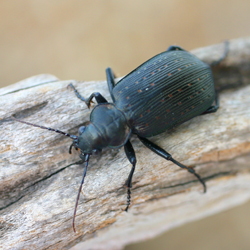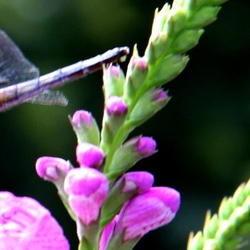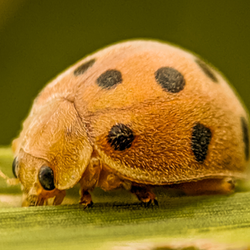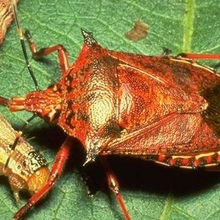One of the most attractive insects is also one of the most helpful. Caterpillar hunters are large, nimble beetles in the genus Calosoma and the Calosoma scrutator is a lovely example. This metallic green beetle flashes gold and blue, with a reddish line around the outside edge of its body. The common name, (Fiery Searcher) for these insects gives us a clue as to their purpose. They are voracious predators and feed primarily on caterpillars.
These ground beetles are always on the hunt, quickly scuttling through the grass and over leaves, searching for their favorite meal. They tend to favor the caterpillars of quite a few destructive pests; the Colorado potato beetle, larvae, pupae, and eggs of root maggots and flies; larvae of imported cabbage worm and gypsy moth, diamondback moths, cutworm and cabbage loopers, aphids, asparagus beetles, slugs, flea beetles, and some species even eat snails. Their diet should make them a welcome resident in any vegetable garden or perennial bed. Giving them a light cover of mulch or debris encourages them to hang around and reproduce.
 Overwintering adults emerge from their underground burrows in early summer, just about the time that their favorite food species are plentiful. They lay their eggs and once the larvae hatch, they have mighty appetites as well, munching their way through the bad bugs for two to four weeks. The larvae have large heads and fierce looking jaws that grasp the unlucky victim in a vise-like grip. The adults also have strong mandibles and can give a respectable nip if mis-handled, but they have no venom and the bite is harmless. When disturbed they emit a foul odor that is probably designed to ward off predators further up the food chain as a defensive measure.
Overwintering adults emerge from their underground burrows in early summer, just about the time that their favorite food species are plentiful. They lay their eggs and once the larvae hatch, they have mighty appetites as well, munching their way through the bad bugs for two to four weeks. The larvae have large heads and fierce looking jaws that grasp the unlucky victim in a vise-like grip. The adults also have strong mandibles and can give a respectable nip if mis-handled, but they have no venom and the bite is harmless. When disturbed they emit a foul odor that is probably designed to ward off predators further up the food chain as a defensive measure.
There are a number of related species all around the world; some brightly colored, others clad in basic black. The similar, but smaller Calosoma sycophanta, a native of Europe was introduced into the eastern U.S. in 1905 to help combat the gypsy and brown-tail moths that were ravaging the forests of the east coast. It has naturalized and helps control the population of this destructive pest.
These are nocturnal beetles and are drawn to lights, but they are agile and fast. They are the cheetahs of the insect world, deadly night-hunters that can run their prey to the ground in seconds. Most destructive caterpillars emerge from their nests to feed at night and this beautiful predator stalks them without mercy. It is a sign of a healthy garden to have these good guys on the hunt, so leave them to go about their business. There will be fewer pests that you'll have to deal with if you do.
Find this bug and others in BugFiles

















